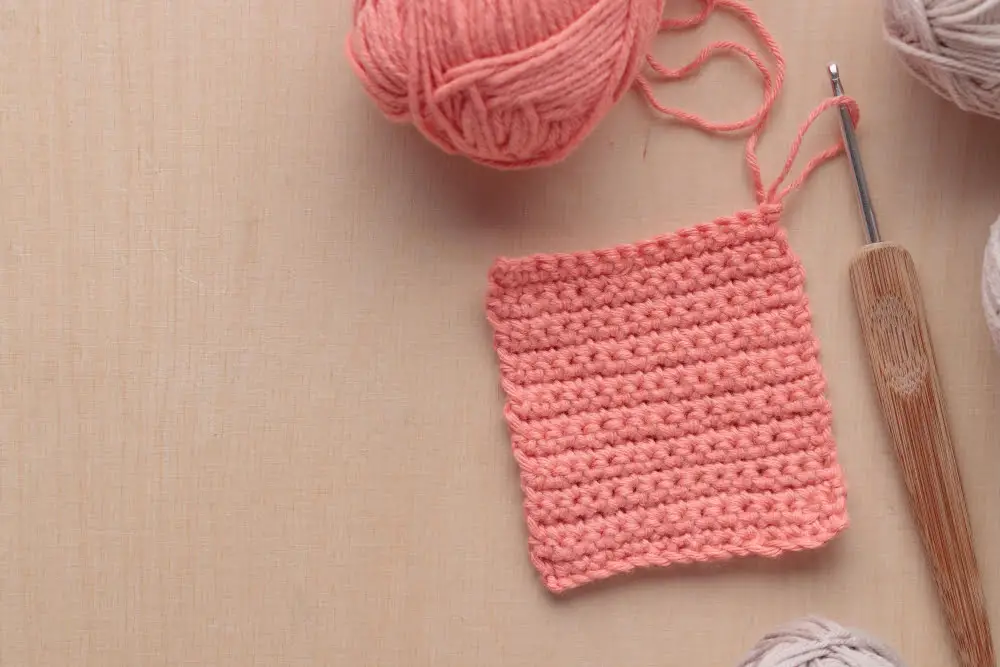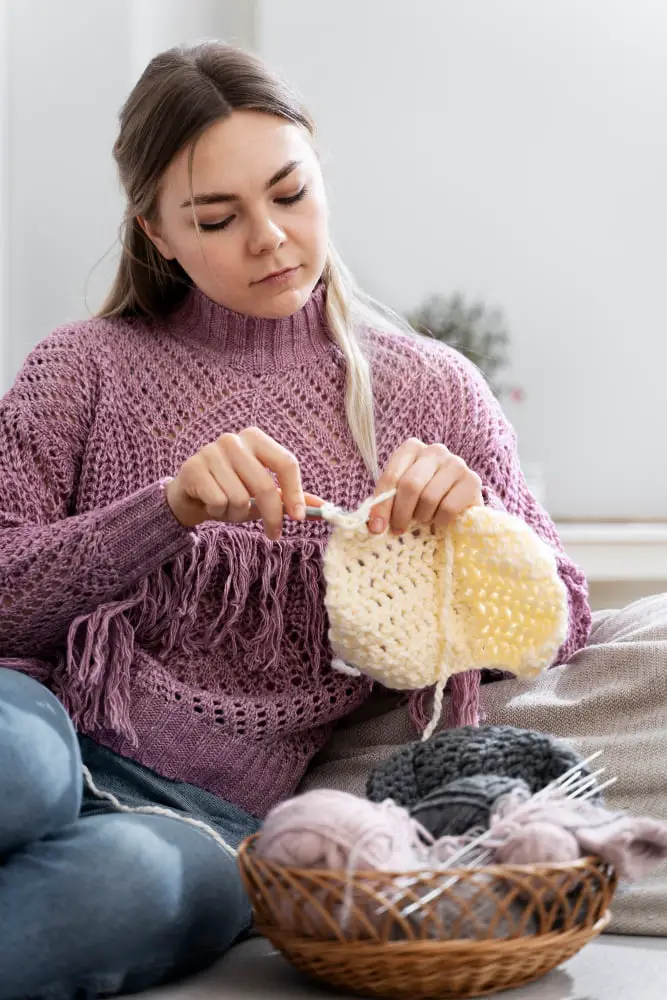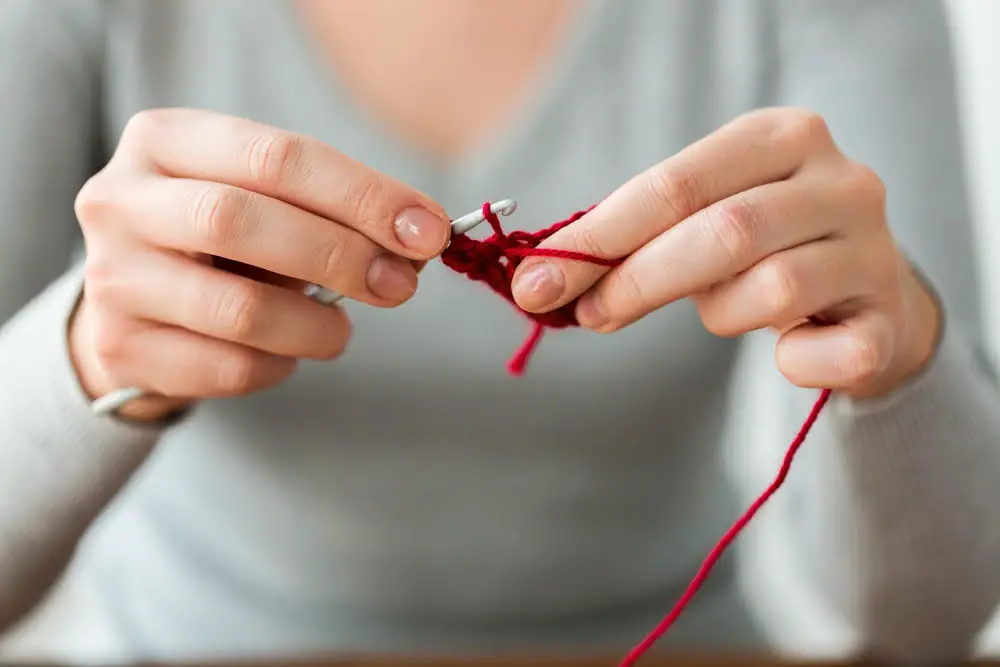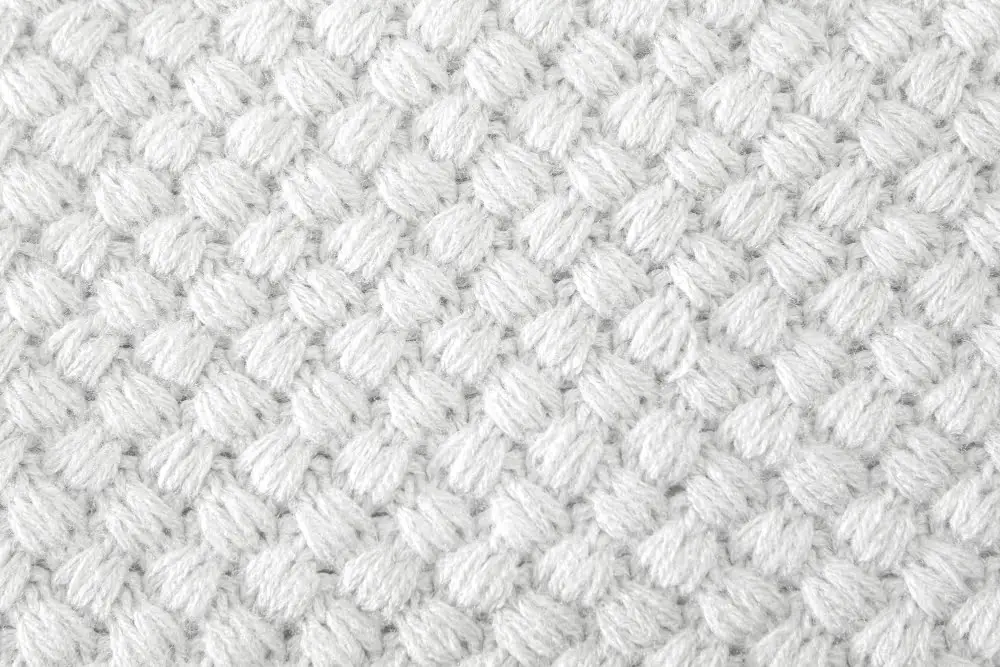Discover the beautiful world of crochet stitches for blankets as we explore various types and techniques to create your cozy masterpiece.
Are you tired of using the same old crochet stitch for every blanket project? Do you want to add some variety and texture to your creations? Look no further! In this article, we will explore different types of crochet stitches that are perfect for making cozy and beautiful blankets. From simple single crochets to more intricate shell stitches, there is something for every skill level and style preference.
So grab your hook and yarn, and let’s dive into the world of crochet stitches for blankets!
Single Crochet Stitch

The single crochet stitch is one of the most basic and versatile stitches in crocheting. It creates a tight, dense fabric that is perfect for making warm blankets.
To work this stitch, insert your hook into the next stitch, yarn over and pull up a loop (you should have two loops on your hook), then yarn over again and pull through both loops on your hook.
One great thing about the single crochet stitch is its simplicity – it’s easy to learn even if you’re new to crocheting. Plus, it works up quickly so you can make progress on your blanket project faster than with some other stitches.
Another advantage of using single crochet for blankets is that it creates a sturdy fabric that will hold up well over time. This makes it an ideal choice for baby blankets or any other type of blanket that will get lots of use.
If you want to add some texture or interest to your blanket while still keeping things simple with the single crochet stitch, try working in different colors or changing where you place each new row (front loop only vs back loop only). You could also experiment with adding stripes or incorporating other types of stitches like bobbles or clusters into sections throughout the pattern.
Double Crochet Stitch

It’s slightly taller than the single crochet stitch, making it perfect for creating more open and airy designs. To work this stitch, you’ll need to know how to chain stitches and make a foundation row of single crochets.
To begin the double crochet stitch, yarn over your hook once before inserting it into the next chain or space in your foundation row. Yarn over again and pull through the first loop on your hook (you should now have three loops on your hook).
Yarn over once more and pull through two loops on your hook (two loops remaining). Yarn over one last time and pull through both remaining loops.
Repeat this process across each chain or space in the foundation row until you reach the end of the row. Then turn your work around so that you’re ready to start another row of double crochets.
One great thing about using double crochet stitches for blankets is that they work up quickly due to their height compared with other basic stitches like single or half-double crochets. You can also experiment with different variations such as front post or back post double crochets which add texture by working around previous rows instead of into them directly.
Half-Double Crochet Stitch

It creates a dense, yet flexible fabric with a slight texture that’s perfect for blankets. To work this stitch, you’ll need to know how to chain and yarn over.
To begin, make a foundation chain of any length. Then insert your hook into the third chain from the hook (the first two chains count as your first half-double crochet).
Yarn over once and pull up a loop (you should have three loops on your hook). Yarn over again and pull through all three loops on your hook.
Repeat this process across the row until you reach the end of the row or desired length. When working subsequent rows, remember to start with two chains before beginning each new row.
The half-double crochet stitch is great for creating textured patterns like basketweave or waffle stitches while still maintaining an even tension throughout your blanket project.
Triple Crochet Stitch

This stitch is worked similarly to the double crochet but with an extra yarn over before inserting the hook into the next stitch. The result is a tall and airy fabric that works up quickly.
To work this stitch, begin by chaining multiple stitches as your foundation row. Then, yarn over twice before inserting your hook into the fourth chain from your hook (or desired starting point).
Yarn over again and pull through two loops on your hook three times until you have one loop left on your hook.
Repeat this process across each chain in the foundation row until you reach the end of the row. For subsequent rows, start with three chains (counts as first triple crochet) then work one triple crochet in each space across to create a beautiful textured blanket.
The triple crochet can also be combined with other stitches such as single or double crochets to create unique patterns within a blanket project. Experimenting with different combinations of stitches can lead to stunning results!
Slip Stitch

It’s also great for adding texture to your blanket by creating a subtle ribbed effect. To work the slip stitch, insert your hook into the next stitch or space, yarn over and pull through both loops on your hook in one motion.
While it may seem simple compared to other crochet stitches for blankets, don’t underestimate its versatility! You can use slip stitches in combination with other types of crochet stitches like single crochets or double crochets to create unique patterns and textures.
One popular way of using this technique is by working rows of alternating single crochets and slip stitches. This creates an interesting woven look that adds depth and dimensionality to any project.
Shell Stitch

This stitch creates a series of shells or scallops, which are made up of multiple double crochets worked into the same space. The result is a lacy, openwork pattern that looks intricate but is actually quite simple to create.
To work the shell stitch, you will need to know how to chain and double crochet. Start by chaining an even number of stitches for your foundation row.
Then, skip the first three chains (these count as your first double crochet) and work two more double crochets into the fourth chain from your hook.
Next, skip two chains and single crochet in the next chain. Repeat this pattern across until you reach the end of your row.
For subsequent rows, start by chaining three (this counts as your first double crochet). Then work two more doubles in between each shell from the previous row’s single crochets.
Continue working rows like this until you have reached your desired length or completed enough shells for one side if making an afghan square.
V-Stitch

This stitch is created by working two double crochets, a chain stitch, and then two more double crochets all in the same space or stitch. The result is a “V” shape that gives the V-stitch its name.
One of the great things about this stitch is how quickly it works up. It’s perfect for those who want to create something beautiful but don’t have hours upon hours to devote to their projects.
Another benefit of using the V-stitch in your blankets is its versatility. You can use it as an accent row between other stitches or work entire rows with just this one pattern for an eye-catching effect.
To get started with this fun and easy-to-learn crochet technique, simply grab your hook, yarn, and follow these simple steps:.
- ) Chain any even number of stitches.
- ) Work one double crochet into each chain across.
- ) Chain 3 (counts as first dc), skip next st., *work (dc,ch1,d c )in next st., skip 2 sts.; repeat from *to last 3 sts; work dc in last st.
- ) Turn; ch 3(counts as first dc),*work(dc,ch1,d c )in center ch-1 sp of each shell across: end dcin top turning-ch
- ) Repeat step four until you reach your desired length
Cluster Stitch

This stitch involves working multiple stitches together into one, creating a “cluster” of stitches. The number of stitches worked in each cluster can vary depending on the desired effect.
To work the basic cluster stitch, you will typically work several double crochets (or other designated stitches) into the same space or chain before completing them all at once by pulling through all loops on your hook. This creates a raised bump or “cluster” that stands out from the rest of your fabric.
Cluster stitching is perfect for adding interest to simple designs like stripes or solid color blankets, but it also works well as an accent within more complex patterns like granny squares or chevron designs.
Bobble Stitch

This stitch creates small, raised bumps that give the blanket a unique look and feel. To create this stitch, you will work several double crochets into one stitch, then pull them all through at once to form the bobble.
One of the great things about using the bobble stitch in your blanket is that it can be used as an accent or as an all-over pattern. You can use different colors for each bobble or keep them all uniform for a more subtle effect.
If you’re new to crochet or just learning how to do bobbles, don’t worry! There are plenty of tutorials available online that will guide you through each step of creating this fun and versatile stitch.
Popcorn Stitch
This stitch creates little puffs that pop out from the surface of your work, giving it a three-dimensional look and feel. To make this stitch, you will need to work several double crochets into the same stitch or space, then pull up a loop through all of them at once.
You’ll finish off by working one chain stitch on top of the popcorn.
One great thing about using the popcorn stitch in your blanket projects is that it can be used in different ways depending on how you arrange them – for example, creating rows or clusters with other stitches like single crochets or half-double crochets.
Puff Stitch

This stitch creates a raised, three-dimensional look that adds depth and interest to any project. To create the puff stitch, you will work multiple stitches into one space before pulling them all through at once.
One of the great things about the puff stitch is its versatility. You can use it in combination with other stitches or on its own for an eye-catching effect.
It’s also perfect for creating soft and cozy blankets that are perfect for snuggling up under on chilly nights.
If you’re new to crochet or just learning how to do different types of stitches, don’t worry! The puff stitch may seem intimidating at first glance but it’s actually quite simple once you get the hang of it.
Waffle Stitch
This stitch creates a beautiful, raised pattern that resembles the texture of waffles. It’s perfect for adding warmth and depth to your blanket projects.
To create the waffle stitch, you will need to know how to work front post double crochet (FPDC) and back post double crochet (BPDC). These stitches are worked around the posts of previous stitches rather than into the top loops like regular double crochets.
To start, chain an even number of stitches plus two additional chains for turning. Then work one row of single crochets across your foundation chain before beginning with FPDCs in every other stitch on your second row.
On subsequent rows alternate between FPDCs and BPDCs until you reach your desired length.
Basketweave Stitch

This stitch involves alternating between front post double crochets and back post double crochets to create the illusion of weaving. The result is a beautiful and cozy blanket with an interesting texture.
To work the basketweave stitch, you will need to have some experience with basic crochet stitches such as single crochet, double crochet, and chain stitches. Once you get the hang of it though, this pattern can be quite easy to follow.
One great thing about using the basketweave stitch for your blanket project is that it works up quickly due to its bulky nature. You can also experiment with different color combinations or use variegated yarns for added interest.
Ripple Stitch

This stitch is perfect for creating cozy and warm blankets with an interesting texture. The ripple effect can be achieved by alternating between increases and decreases in the number of stitches, creating peaks and valleys along the length of your blanket.
To create this stitch, you will need to know how to double crochet (DC) and decrease stitches. Once you have mastered these techniques, you can easily create stunning ripple blankets in no time! There are many variations of this popular stitch including chevron or zig-zag patterns.
One great thing about using the Ripple Stitch for your blanket project is that it works well with any color combination or yarn weight. You can use bright colors for a fun baby blanket or muted tones for an elegant throw.
Tunisian Crochet Stitch

It creates a dense and textured fabric that’s perfect for blankets. Tunisian crochet uses an elongated hook with a stopper on one end to keep stitches from falling off.
To create this stitch, you’ll need to work in two passes: forward pass and return pass. The forward pass involves picking up loops from right to left while keeping them on the hook.
Then you’ll work your way back by pulling yarn through each loop until only one remains.
The result is a beautiful woven-like texture that looks great in solid colors or variegated yarns. You can use Tunisian crochet for entire blankets or mix it with other stitches for added interest.
If you’re new to Tunisian crochet, there are plenty of tutorials available online along with free patterns specifically designed for this technique.
Corner-to-Corner Stitch

This stitch involves working in blocks or squares from one corner to the opposite corner and then joining them together to form the final piece. The beauty of this stitch lies in its versatility; you can use it with any yarn weight and hook size to create different textures and designs.
To start your C2C blanket, you will need to chain 6 stitches before making your first block. Then work double crochet (DC) stitches into each chain starting from the fourth chain from your hook until you have three DCs total plus one turning chain at the end of that row.
For each subsequent row, increase by adding another block on top of what was previously made while decreasing on either side until only two blocks remain before finishing off at last square’s edge.
Once all squares are completed according to pattern instructions or desired size has been reached join them together using slip stitching along edges where needed so they lay flat without puckering up too much when sewn together later on!.
Granny Square Stitch

It’s a versatile stitch that can be made in any color combination and size, making it perfect for all kinds of projects. The best part about the Granny Square Stitch is its simplicity – even beginners can master this stitch with ease.
To make the Granny Square Stitch, you will need to know how to chain, slip stitch and double crochet. Once you have these basic skills down pat, creating your first granny square will be easy! Simply start by chaining four stitches and then join them together with a slip stitch to form a ring.
Next, work three double crochets into the center of the ring followed by two chains before working another set of three double crochets into the same space as before. Repeat this pattern until you have four sets of three double crochets separated by two chains each.
Join your last set of stitches with a slip-stitch into your starting chain-four loop and voila! You’ve created one round or “square” in your granny square blanket!.
You can continue adding rounds using different colors or patterns until you reach your desired size or design aesthetic. Granny squares are also great building blocks for larger projects like afghans because they’re easy to connect together using single crochet stitches along their edges.
Star Stitch
It’s perfect for adding some visual interest to your blanket projects. To create the star stitch, you’ll need to know how to work single crochets, double crochets, and chains.
To start the first row of stars: chain an even number of stitches plus one (for example 15+1=16). Then make two single crochets in the second chain from hook.
Insert your hook into next chain space and pull up a loop (3 loops on hook), insert it again into same space and pull up another loop (5 loops on hook), repeat this process until there are six loops on your hook. Next step is yarn over with working yarn around needle once more time then draw through all six loops at once; ch 1.
For subsequent rows: turn work; *work 2 sc in eye of previous row’s “star”; insert hk behind vertical bar between sts below last worked st & under strand at back of “eye” just made; yo & draw lp through both strands onto hk* rep from * across ending with hdc in turning ch-1 sp.
Once you get comfortable with this technique, try experimenting by using different colors or changing up where you place each “star” within your blanket design.
Alpine Stitch
This stitch is perfect for creating cozy blankets with an alpine-inspired look and feel. The Alpine Stitch involves working alternating rows of single crochets and double crochets in the same row, which creates a dense fabric with lots of texture.
To work the Alpine Stitch, you will need to know how to do basic single crochet (sc) and double crochet (dc) stitches. Once you have mastered these stitches, follow these steps:
- Chain an even number of stitches.
- Row 1: Sc in second chain from hook and each chain across.
- Row 2: Ch 3 (counts as dc), turn work; *skip next st., dc into next st.; ch 1* repeat from *to* until last sc; end by skipping last sc.
- Row 3: Ch 1, turn work; sc into first st., then every other ch-1 space across ending with one final sc at end of row.
Repeat Rows two & three until your blanket reaches your desired length.
Blanket Stitch

It’s perfect for adding an extra touch of elegance to your finished project. This stitch is worked by creating single crochets along the edge of the blanket, then working a chain stitch before making another single crochet in the next space.
One great thing about this stitch is that it can be easily customized to fit any size or style of blanket. You can make it wider or narrower depending on your preference, and you can also experiment with different colors to create unique effects.
If you’re new to crocheting, don’t worry! The Blanket Stitch is relatively easy to learn and perfect for beginners who want to add some flair without getting too complicated. With just a little practice, you’ll be able to master this versatile technique in no time!
Cable Stitch

This stitch creates the illusion of interwoven cables, making it perfect for creating cozy blankets with a traditional feel. The cable stitch can be worked in various ways, including using front post double crochets or back post double crochets to create the raised effect.
To work the cable stitch, you will need to have some experience with basic crochet stitches such as single and double crochet. Once you have mastered these techniques, you can easily learn how to make beautiful cables by following step-by-step instructions or video tutorials.
One great thing about this versatile technique is that it works well with different types of yarns and colors. You can use bulky yarn for a chunky look or opt for lighter weight yarns if you prefer something more delicate.
Crocodile Stitch
This stitch resembles the scales of a crocodile, hence its name. It involves working double crochets in two different rows and then joining them together with slip stitches to create the scale-like texture.
To work this stitch, you will need to have some experience with basic crochet stitches such as single and double crochet. Once you get the hang of it, though, it’s easy to create beautiful blankets using this technique.
The Crocodile Stitch works well for creating borders or edging on blankets or even as an all-over pattern for more advanced projects. You can use any type of yarn weight or color combination that suits your style preference.
Herringbone Stitch
This stitch creates a diagonal pattern that resembles the bones of a herring fish, hence its name. The Herringbone Stitch is worked by crocheting half double crochet stitches in alternating directions, which gives it its distinctive slanted look.
To create this stunning stitch, you will need to know how to work the half-double crochet (HDC) and slip stitches. Once you have mastered these basic techniques, you can easily learn how to make the Herringbone Stitch with our step-by-step tutorial.
One of the great things about using this particular type of crochet stitch for blankets is that it works up quickly due to its repetitive nature. You’ll be able to see your progress as each row adds more dimensionality than traditional single or double crochets would provide.
FAQ
Which crochet stitch is best for a blanket?
The double crochet stitch is the best for blankets due to its simplicity, quick work-up, and basic nature, despite its high yarn usage.
What is the easiest stitch for crocheting a blanket?
The easiest stitch for crocheting a blanket is the Single Crochet Stitch, as it is the fastest for beginners and can be followed by other basic stitches like half-double and double crochet.
What is the best stitch for an Afghan?
The best stitch for an Afghan is the half double crochet, as it is a popular basic stitch, simple to learn, works up fast, and creates satisfying bobbly clusters that are easy to master.
What are some popular crochet stitches for creating a warm and cozy blanket?
Some popular crochet stitches for creating a warm and cozy blanket include the single crochet, double crochet, half-double crochet, treble crochet, and cable stitch.
How to choose the right crochet stitch for a baby blanket?
To choose the right crochet stitch for a baby blanket, consider selecting a stitch that is soft, warm, and easy to work with, such as the single crochet, half-double crochet, or double crochet stitch.
Can you recommend some beginner-friendly crochet stitches for making a throw blanket?
Some beginner-friendly crochet stitches for making a throw blanket include single crochet, double crochet, half-double crochet, and granny square.





